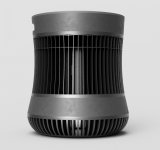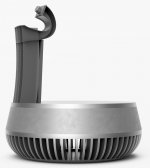I’m fairly new at speaker building and shy away from many traditional designs looking for something different to work on.
I have found a liking for omnidirectional speakers. After make my first I realise the 6 speakers caused an amount of lobing that I seek to try to eliminate.
I researched what is available on Apples HomePod and they seem to use 7 drivers for mid/highs without noticeable lobing effect.
I am working on a larger beast with 12 inch subwoofer down facing and 16 mini speakers using load folded horn design as shown in the picture. Dsp will flatten the speaker freq response.
What should I be looking out for to get the best omnidirectional point source response? Appreciate your experience and comments.
Cheers
Tony

I have found a liking for omnidirectional speakers. After make my first I realise the 6 speakers caused an amount of lobing that I seek to try to eliminate.
I researched what is available on Apples HomePod and they seem to use 7 drivers for mid/highs without noticeable lobing effect.
I am working on a larger beast with 12 inch subwoofer down facing and 16 mini speakers using load folded horn design as shown in the picture. Dsp will flatten the speaker freq response.
What should I be looking out for to get the best omnidirectional point source response? Appreciate your experience and comments.
Cheers
Tony

Last edited:
All tidied up 🙂
(your posts would not appear immediately because as an infrequent poster you were still under moderation)
(your posts would not appear immediately because as an infrequent poster you were still under moderation)
Hi TNT,
As I am using 1 speaker per 16 segments arranged horizontally around the speaker. Not sure I understand the vertical dispersion bit which the horn would disperse. Are you able to elaborate?
As I am using 1 speaker per 16 segments arranged horizontally around the speaker. Not sure I understand the vertical dispersion bit which the horn would disperse. Are you able to elaborate?
A lot depends on your goals. The following commentary assumes you are trying to construct a standard 2-channel system that images normally.
One thing you haven't brought up is that Apple seems to be using independent amplification and DSP/time delays for each driver. This can shape the output. It can also be used to precisely nullify time delay issues for one listener location (your lobing concern). Optimizing badly aligned drivers for a single location is not normally the goal for high-end audio though, as it can sacrifice off-axis performance.
There's likely an Apple patent that gives more detail, but this article provides a little info
A deep dive into HomePod's adaptive audio, beamforming and why it needs an A8 processor | Appleinsider
"In the case of Apple, it's using array of six microphones and a digital signal processor (DSP) to understand the environment based on its acoustics, and adapt the device's output to better suit its physical location and the room's audio profile. Considering the multiple speakers and the microphone array, it is possible for such a system to customize the output of each speaker to allow for a similar sound to be heard through as much of the environment's space as possible.
If HomePod is running a realtime DSP that can alter the sound emitted from each of the device's seven tweeter speakers, it can constantly change the profile even if the environment itself changes, such as the mass of the listener moving to a different location in the same area. The experience is consistent regardless of position, with Hines adding the consistency will make listening to music "more seamless and more immersive."
. . .
"'A true stereo setup for HomePod would be a bad user experience, which Apple aren't in the business of offering.'
By using this audio adaptation, which Apple has attempted to patent, it means that the HomePods are able to take each other into account, so the stereo experience will still be present and enjoyable for those near enough to them to hear it, while still keeping the audio listenable in other areas of the room."
One thing you haven't brought up is that Apple seems to be using independent amplification and DSP/time delays for each driver. This can shape the output. It can also be used to precisely nullify time delay issues for one listener location (your lobing concern). Optimizing badly aligned drivers for a single location is not normally the goal for high-end audio though, as it can sacrifice off-axis performance.
There's likely an Apple patent that gives more detail, but this article provides a little info
A deep dive into HomePod's adaptive audio, beamforming and why it needs an A8 processor | Appleinsider
"In the case of Apple, it's using array of six microphones and a digital signal processor (DSP) to understand the environment based on its acoustics, and adapt the device's output to better suit its physical location and the room's audio profile. Considering the multiple speakers and the microphone array, it is possible for such a system to customize the output of each speaker to allow for a similar sound to be heard through as much of the environment's space as possible.
If HomePod is running a realtime DSP that can alter the sound emitted from each of the device's seven tweeter speakers, it can constantly change the profile even if the environment itself changes, such as the mass of the listener moving to a different location in the same area. The experience is consistent regardless of position, with Hines adding the consistency will make listening to music "more seamless and more immersive."
. . .
"'A true stereo setup for HomePod would be a bad user experience, which Apple aren't in the business of offering.'
By using this audio adaptation, which Apple has attempted to patent, it means that the HomePods are able to take each other into account, so the stereo experience will still be present and enjoyable for those near enough to them to hear it, while still keeping the audio listenable in other areas of the room."
If you are OK designing a complex horn, you may get better results with a single driver whose output is distributed by the horn. Since you haven't provided any details about your horn geometry, I'm not sure what you're doing inside.
Some interesting omni ideas:
US patent 3,773,976 by Beveridge
US patent 4,496,021 by Berlant
US patent 5,615,176 by LaCarrubba
Duevel Sirius Omnidirectional Speaker | Sound & Vision
Some interesting omni ideas:
US patent 3,773,976 by Beveridge
US patent 4,496,021 by Berlant
US patent 5,615,176 by LaCarrubba
Duevel Sirius Omnidirectional Speaker | Sound & Vision
@mattstat,
Thanks for some interesting reading. I don't have the capability's to produce an auto adjusting speaker with environmental inputs and dsp adjustments.
I'll continue down my path of multidriver emulating a point source as it is in my capability. One horn profile can be shown in the attachment. This shows one of 16 segments I'll create. The delay in propagation through the folded horn should correspond to the same length as what would be the centre of the speaker so I am hoping to have the 16 drivers represent one driver emanating from a virtual centre point providing a single source point.
I am aware of room effects but I have limited effect on these in the design. A DSP will correct and speaker tuning deficiencies.
Thanks for some interesting reading. I don't have the capability's to produce an auto adjusting speaker with environmental inputs and dsp adjustments.
I'll continue down my path of multidriver emulating a point source as it is in my capability. One horn profile can be shown in the attachment. This shows one of 16 segments I'll create. The delay in propagation through the folded horn should correspond to the same length as what would be the centre of the speaker so I am hoping to have the 16 drivers represent one driver emanating from a virtual centre point providing a single source point.
I am aware of room effects but I have limited effect on these in the design. A DSP will correct and speaker tuning deficiencies.
Attachments
Hi TNT,
As I am using 1 speaker per 16 segments arranged horizontally around the speaker. Not sure I understand the vertical dispersion bit which the horn would disperse. Are you able to elaborate?
A point source is radiating in a 360 deg sphere. Your horns will not radiate e.g. upwards... or?
//
I heard this speaker in Munich a few years back. I played really nicely and loud for it's size.
LEGEND 4000 Precision Sound Reproducers by John Watkinson
Legend Precision Sound Reproducers
LEGEND 4000 Precision Sound Reproducers by John Watkinson
Legend Precision Sound Reproducers
What's the point of a true omni, ie 360 degree spherical radiation?
A point source is 360. It was not my claim but rather a goal set by the thread starter.
Well lets say like this - if anyone could truly build one, I would be in queue for a set.
//
One horn profile can be shown in the attachment. This shows one of 16 segments I'll create. The delay in propagation through the folded horn should correspond to the same length as what would be the centre of the speaker so I am hoping to have the 16 drivers represent one driver emanating from a virtual centre point providing a single source point.
I understand that you don't intend to implement the amount of DSP they do or use it for the same reasons. My concern was that you may have been thinking the physical layout of the HomePod is responsible for things that the DSP is controlling.
My main concern is where the acoustic center of your horn/waveguide winds up landing and if it moves with frequency (relatively common for horns). I haven't built anything like what you are proposing, so can't talk from experience or predict how everything is going to interact.
I'm just speculating, and my design goals place simplification up the priority list, so take my worries with a grain of salt. I'm not trying to discourage you from pursuing your design. It is interesting, and may do what you want it to. Wherever the project leads you, I hope you'll share the results. New designs are nice to see.
@mattstat, thanks but don't worry I'm not easily discouraged. My limited understanding of horns is the 1. are efficient and can increase gain of the driver by approx 10dB, needed as these are relatively low power, low efficiency drivers. 2. The frequency can change in the beam width. I guess geometry of the horn counts here. I'm doing some more reading but would like to know more on your concerns you pointed out.
A very untraditional and omnidirectional design is this one: My 34c9 (omnidirectional full range with 3FE22) build - some more information by the inventor here: MDD Multi Delays Diffraction (Multi TL, omnidirectional, single drive, ...)
I built a pair and with a subwoofer and a little EQ, you get some really nice speakers with room-filling sound.
I built a pair and with a subwoofer and a little EQ, you get some really nice speakers with room-filling sound.
@pelanj, what a bizarre concept. Looking at it I cannot believe it could work. Sorry but my science has not extended that far yet. Are there any other examples?
What's the point of a true omni, ie 360 degree spherical radiation?
Acoustic measurements for concert halls.
- Home
- Loudspeakers
- Planars & Exotics
- Point source omnidirectional speaker.

 that's it.
that's it.